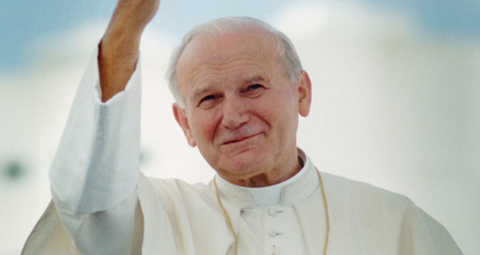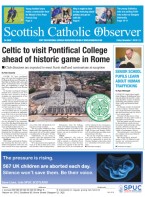September 16 | ![]() 0 COMMENTS
0 COMMENTS ![]() print
print

We’ve built a respectful relationship
Church of Scotland magazine editor Lynne McNeil on Christian unity and solidarity
GROWING up in the Scotland of the 1970s and early 1980s there were clear divisions between the two biggest Christian denominations in the country.
The national Church of Scotland had a presence—and more—in every town. The Catholic Church generally had a presence, but was distinct in having its own schools.
As an East Coast native, life was perhaps a little different to those central and West Coast communities, and the only contrast among friends was that they went to a ‘different’ school and subsequently had a longer school day because of the additional travel involved in attending the local RC primary and secondary schools, which sat in neighbouring towns.
Yet, travel westwards and the divisions and rivalries were pointed at that time, evidenced in the tribalism of Old Firm football, entrenching Catholic and Protestant rivalries, although the clubs involved have done much to tackle the bigotry that was once commonplace on terrace and street alike.
Today, the picture could not be more different. Ecumenism is expected—and no longer surprising. Christian communities of faith work hand in hand, setting aside doctrinal difference for common aims and goals.
As the magazine of the Church of Scotland—with editorial independence —we as a team regularly report on shared services with our sister Catholic churches. A recent story of a Church of Scotland offering its building for worship to fellow Catholic Christians after their church was destroyed by fire barely raised an eyebrow.
As marriage within the Christian church declines, thanks in part to changes in civil legislation, shared marriage services, where there are affiliations to both denominations, are also regular features of minister and priest diaries alike.
What was unthinkable in 1970s Scotland is now regarded as normal in the 21st century.
The pivotal moment can be traced back to 1982—and the historic visit to Scotland of Pope John Paul II.
In an address at Bellahouston Park in Glasgow, attended by an estimated 300,000 people, he paved the way for a new chapter of healing and walking together.
In a speech that was widely interpreted as opening the door for the Catholic Church in Scotland to work with sister denominations, he said: “Before concluding, I wish to address for a few moments that larger community of believers in Christ, who share with my Catholic brothers and sisters the privilege of being Scots, sons and daughters alike of this ancient nation.
“I know of the veneration in which you hold the Sacred Scriptures, accepting them for what they are, the word of God, and not of man.
“I have reserved until now and should like to read to you the remaining words from that passage of St Paul’s letter to the Ephesians: ‘There is one body, one Spirit, just as you were all called. There is one Lord, one faith, one baptism, and one God who is Father of all, over all, through all and within all’ (Eph. 4, 5-6).
This passage clearly reveals the will of God for mankind, a plan human wills may oppose but cannot thwart. It is God’s plan for all of us, ‘for there is no eternal city for us in this life but we look for one in the life to come’(Hebr. 13, 15).
“We are only pilgrims on this earth, making our way towards that heavenly Kingdom promised to us as God’s children. Beloved brethren in Christ, for the future, can we not make that pilgrimage together hand in hand, ‘bearing with one another charitably, in complete selflessness, gentleness and patience,’ doing all we can ‘to preserve the unity of the Spirit by the peace that binds us together?’ (Eph. 4, 2-3).
“This would surely bring down upon us the blessing of God our Father on our pilgrim way.”
During the 36-hour visit, Pope John Paul II also spoke of ‘the happiness of being greeted by the Moderator of the General Assembly of the Church of Scotland, the Right Reverend Professor John McIntyre.’
He spoke warmly of earlier meetings and courtesies between the two churches and was keen to emphasise the importance of the meeting place: outside the General Assembly Hall on the Mound, described as ‘the seat of the Church of Scotland’s Supreme Court,’ linking it to the global ecumenical journey through the 1910 World Missionary Conference, which took place there.
In 1982 this was powerful stuff in ecumenical terms, opening the doors for new relationships between ministers and priests, perhaps exemplified by a young Church of Scotland minister in Renton, Dunbartonshire, keen to embrace the change and build bridges with local priests, at a time and in a place where such partnerships were frowned upon amid raised local passions.
He adopted a very practical form of Christianity, encouraging each church to get to know the other, working together, serving communities together for common aims and causes.
Thirty years on that young minister met Pope Francis in Rome as the then Rt Rev John Chalmers during his year of office as Moderator of the General Assembly of the Church of Scotland in 2014-15. As priest and minister alike took the first tentative steps on the pilgrim path together, formal ecumenical partnerships, both national and local began to take shape.
A second pivotal moment came in 1990. Every year the General Assembly—the highest court of the Church of Scotland—meets for a week in Edinburgh. Representatives of Christian churches both at home and overseas have long been among the visitors invited to attend.
For some time, the Catholic Church in Scotland had been invited to send an observer to the gathering. Observer status meant that the Catholic visitor could listen, but could not speak in any debate taking place on the floor of the Assembly. In an age of warming relationships between the two churches, in the last decade of the 20th century, the status of the Catholic Church’s representative was upgraded to that of delegate, permitting Catholic visitors to have a voice in the decision-making court of the Church of Scotland, although the delegates have no vote on the Assembly floor.
Since then, despite irrevocable doctrinal differences, the door has opened wider and wider. As editor of Life and Work, reports of ecumenical services are now part of the fabric of parish life for the flocks of both the Church of Scotland and Catholic Church in Scotland
Perhaps the biggest indication of the mutual respect that has grown between the two churches came when the Very Rev Dr Andrew McLellan was appointed to head the Catholic Church in Scotland’s Commission for the development of a range of safeguarding initiatives which also considered child sex abuse allegations by priests.
Handing this most sensitive of investigations to a former Moderator of the General Assembly of the Church of Scotland would have been unimaginable in the 1970s, but is a clear sign of the mutual trust and growing bond forged between the two churches.
The rise of secularism has also played its part in driving the two churches closer than they have ever been before, with what, at times, feels like a creeping barrage of attack on faith that seeks to sideline the contribution of Scotland’s churches to our daily lives.
Diminishing numbers of practising Christians in western society has had an impact across Scotland and in an age of reducing resources (not just financially but in terms of those called to serve in ministry or priesthood) the challenges faced by both churches are now broadly similar.
There are common concerns in caring for the poor both at home and overseas and a desire to serve, and a growing realisation that as Christians there is much more to unite us in 21st century Scotland than divide.
The stewardship of God’s land and the spiritual welfare of His people provide common ground and the churches regularly speak with a single voice on particular matters of public concern.
More than 450 years on from the Scottish Reformation, the two churches are perhaps closer than they have ever been before, existing in a spirit of mutual respect, warmth and understanding that some differences are irreconcilable but should not impede the continuing shared journey on the pilgrim path of Christianity in Scotland.
Lynne McNeil is the editor of Life And Work, the magazine of the Church of Scotland










